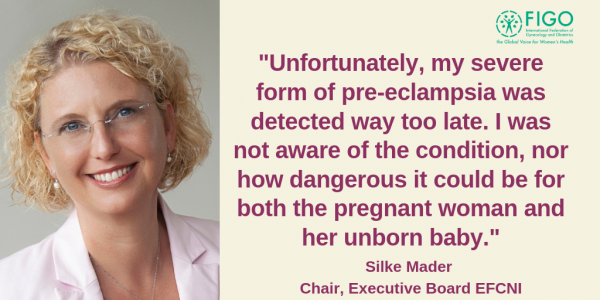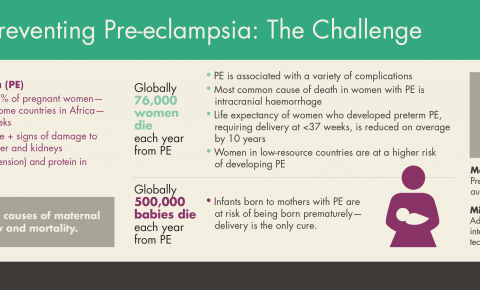FIGO releases new guidelines to combat Pre-Eclampsia
Pre-eclampsia: a global health issue
May 2019, FIGO released Guidelines to combat pre-eclampsia, and calls for all women to receive first-trimester screening.
Read the Pre-eclampsia Guidelines here.
76,000 women and 500,000 babies die each year from hypertension and pre-eclampsia during pregnancy (HAP), making this disorder one of the leading causes of maternal and perinatal morbidity and mortality globally.
The life expectancy of women who develop preterm pre-eclampsia, requiring delivery at <37 weeks, is reduced on an average by 10 years. More women are entering pregnancy with risk factors that make them vulnerable to this complication because of economic and nutrition transition, and the consequent changing lifestyle and demographics.
Addressing hypertension and pre-eclampsia is a critical dimension in reducing maternal and perinatal risks, and preventing long term non-communicable diseases (NCDs). hypertension and pre-eclampsia is fast becoming a priority global health issue given its significant adverse contribution to maternal and newborn child health and the global NCD epidemic.
Read the Pre-eclampsia Guidelines here.
FIGO calls for countries to screen all women in the first trimester, integrating pre-eclampsia risk assessment as an integral part of basic first trimester evaluation protocol.
Universal Screening
All pregnant women should be screened for preterm PE during early pregnancy in the first-trimester with maternal risk factors and blood pressure. Biomarkers offer a potential for early diagnosis and effective treatment, however, the global community recognises that further evidence for its applicability in all populations and ethnic groups is required at this stage.
While several studies have evaluated the role of biomarkers or a combination of physical and chemical measurements, further studies are needed to define their additional role in improving early prediction of preterm PE.
FIGO encourages all countries and its member associations to adopt and promote strategies to ensure quality research and eventual consensus.
Global consensus regarding specific parameters can be impacted both by population characteristics and resource settings. Current research is investigating mean arterial pressure (MAP), serum Placental growth factor (PLGF), uterine artery pulsatility index (UTPI) and pregnancy-associated plasma protein A (PAPP-A).
Downloadable Assets for Social Media
Download the assets in Facebook and Twitter format here.
|
Image
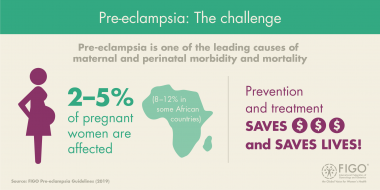
|
Image
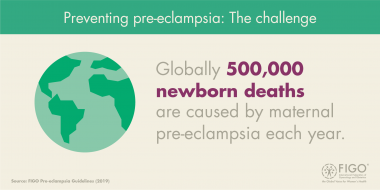
|
|
|
|
||
|
Image
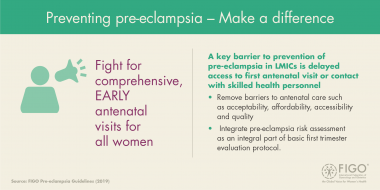
|
Image
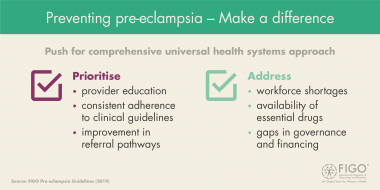
|
Women in low-middle income countries are at high risk of developing pre-eclampsia. It's time to tackle this global #maternalhealth issue. Take a look at @FIGOHQ guidelines www.figo.org/preeclampsia-guidelines
Critical guidelines from @FIGOHQ to tackle pre-eclampsia in #pregnancy are available. Another tool in the fight against the rising tide of #NCDs #maternalmortality http://ow.ly/NMhW50ulaJ8 .@FIGOHQ guidelines launched in @IJGOLive call for universal screening of all women for pre-eclampsia in first trimester through early #antenatal care #maternalhealth #newbornsurvival #HealthforAll http://ow.ly/NMhW50ulaJ8
Pre-eclampsia in #pregnancy leads to greater risk of #NCDs in the long-term for both mother and baby. @FIGOHQ guidelines will help tackle this global #health issue www.figo.org/preeclampsia-guidelines
Messaging for Advocacy Asks
Hypertension and pre-eclampsia (HAP) is a global health issue. If SDG3 is to be achieved, we must prioritise functioning maternal health services, including available and convenient antenatal services for all women, and put greater attention on the link between maternal health and NCDs.
Ask your leaders to:
- invest in skill development for primary health care providers on risk assessment, counselling, ensuring aspirin availability, adherence to drug treatment and comprehensive follow up
- call for comprehensive early antenatal visits for all women that integrates universal screening for preterm pre-eclampsia using a combination of maternal risk factors and bloodpressure.
Identifying a high-risk pregnancy can be life-saving
Silke Mader, Chair of the EFCNI Executive Board, shares her story:
Unfortunately, my severe form of pre-eclampsia was detected way too late – with fatal consequences. My twins had to be delivered via an emergency C-section in gestational week 25. Due to this late diagnosis and emergency surgery, my own life was at stake, we lost our daughter Lena and our son Lukas survived, but was hospitalised for months. Before that, I was not aware of a condition called pre-eclampsia, nor how dangerous it could be for both, the pregnant woman and her unborn baby.
I wish I had been better informed so I could have noticed subtle warning signs like high blood pressure for instance. I also did not know that a look into my family history and my own medical history could have been helpful to identify me as a high-risk patient. Today, I know that there are hints and signs that could be possible symptoms. Identifying a high-risk pregnancy timely can be life-saving.
